THE GOOD LIFE
■ Words & Images by Sam Mossman
A couple of years ago I made good on my long-term escape plan, selling up and moving out of Auckland, semi-retiring and settling in a coastal township further north. After thirty years based in the Big Smoke, I had had enough of the stresses of an increasingly sprawling, overcrowded, unliveable city. I married my longtime partner and we are loving living in a small town with its slower pace of life. I can launch my modest tinny a few minutes from home and have good, handy fishing in sheltered waters.
These days I mostly fish for the table.Feeding yourself and your family is the ultimate, unassailable justification for fishing, in my opinion, but that doesn’t mean it can’t be fun, and challenging as well. There is a good range of table fish in my local waters. Snapper are the primary species available but recent trips have seen gurnard, trevally, john dory, kahawai, kingfish, and even the odd tarakihi, join the reds in the chilly bin.
As a superannuatent I am living on a fixed income now, so need to keep an eye on costs, especially with the soaring cost-of-living levels that we have all suffered recently. Hopefully, we are over the worst of it now although I saw snapper fillets in the supermarket for $52 dollars a kilo the other day (can you believe it!) so the ability to catch our own fish is a big bonus if we want to eat fresh, healthy, kaimoana on a regular basis.
With ease of towing, launching, and retrieving in mind, my retirement boat is a Fish City 4.3m tinny with a 40hp Merc. Small boat fishing has been a get-outof-jail-free card. Even with the rapidly rising cost of fuel, I can still get a day’s fishing for about $30 of gas, which, if you want to look at it another way, is only about the retail cost of one pannie. In this way my recreation can make a meaningful contribution to the household budget as well as providing healthy enjoyment.

Even when you are a pensioner, you still have to pay the taxman.
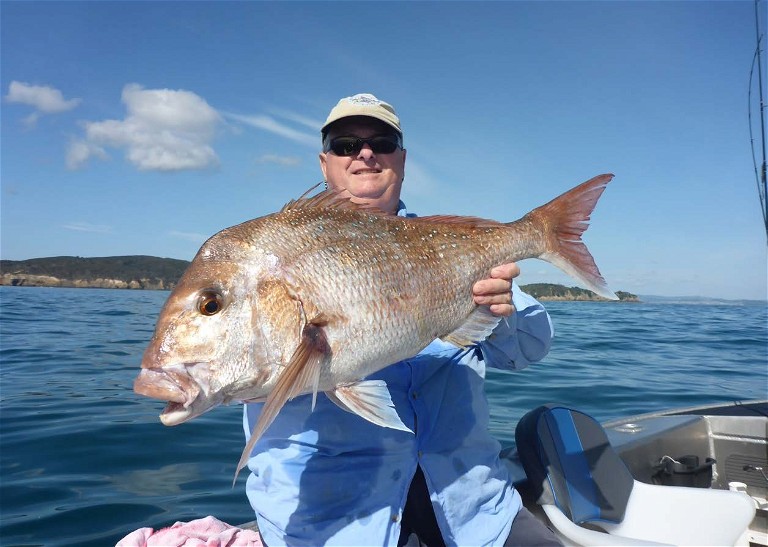
Sam doesn’t specifically target big fish these days, but still encounters a few decent specimens and doesn’t complain when he does.
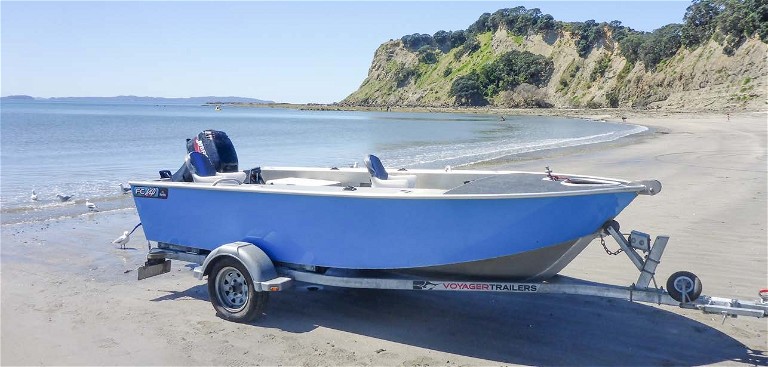
Sam’s FC430 has proven to be an ideal ‘retirement boat’ for him, cheap to run, easy to tow and to launch off a beach.

Fighting fish on light gear is a lot of fun.

Sam’s wife Tracey enjoys a bit of fishing too.
The key to putting the fun and challenge into this type fishing is the tackle and techniques chosen. I have used light tackle most of my fishing life and remain convinced that within practical bounds (say 3-8kg line and a matching rod and reel) lighter gear will provide better results, when bread-andbutter coastal fishing, than heavier gear will. It is more of a challenge and more fun too. The current popularity of softbaiting and other small lure techniques has introduced many anglers to the joys of lighter tackle by default.
I try to be as kind to the fishery as I can. I don’t use methods that specifically target big snapper, although I still encounter a few decent specimens and I don’t complain when I do. However, I reckon the biggest snapper have proven their survival and growth abilities and we want them to remain in the gene pool. But by the same token, with reduced bag limits I want to be catching reasonable-sized fish to provide enough for our needs. When fishing for the table my preference (in snapper) is for medium-sized fish of around one to three kilos and I tailor my techniques to target them (we will get to this in a moment).
You can’t, as the saying goes, bake a cake without breaking eggs, and you can’t always avoid catching undersized or unwanted fish, but I try to minimise potential damage to fish by using lures or decent-sized circle hooks when bait fishing (yes, I still do some) to avoid deep hooking.
Lure size is another thing to consider. It is easier to catch fish on small lures, but you tend to get a lot of small ones, too. Consequently, I keep my soft baits to a reasonable size (mostly 5” tails) to avoid too many little ones. They will still pull at the lure tails, but a lot less are hooked. You may get the impression that you are having a lot of ‘missed strikes’ but you don’t want to hook these little guys anyway.
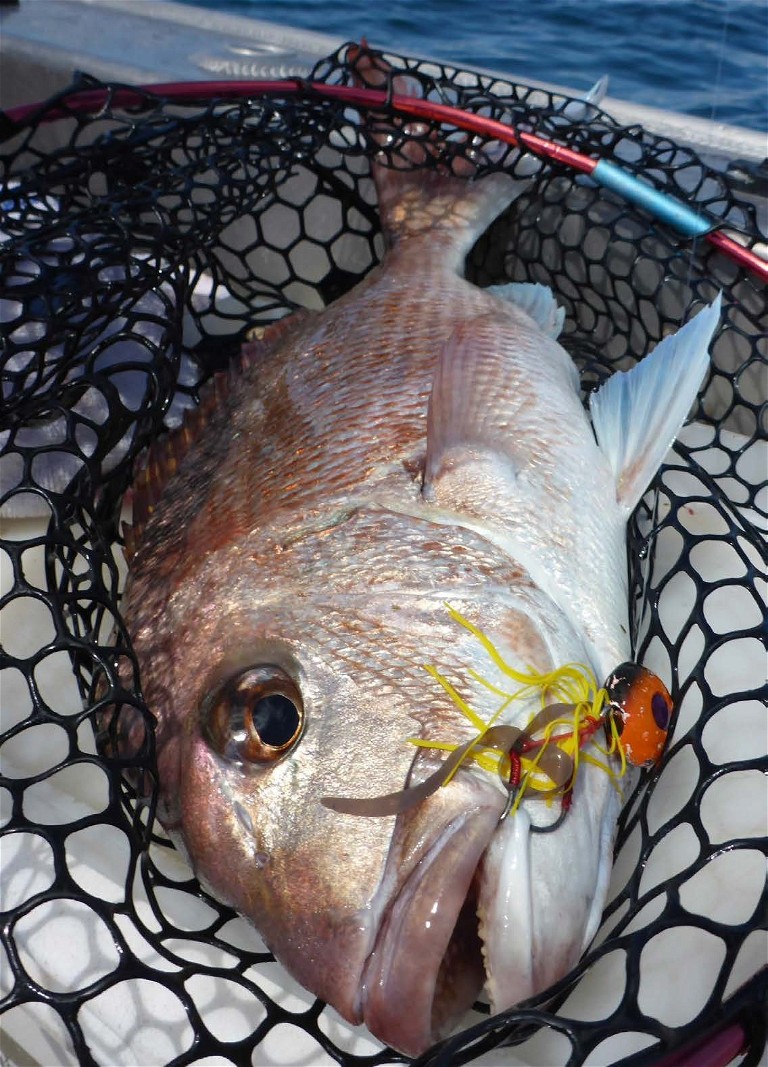
The kabura slider is Sam’s favourite drag lure.
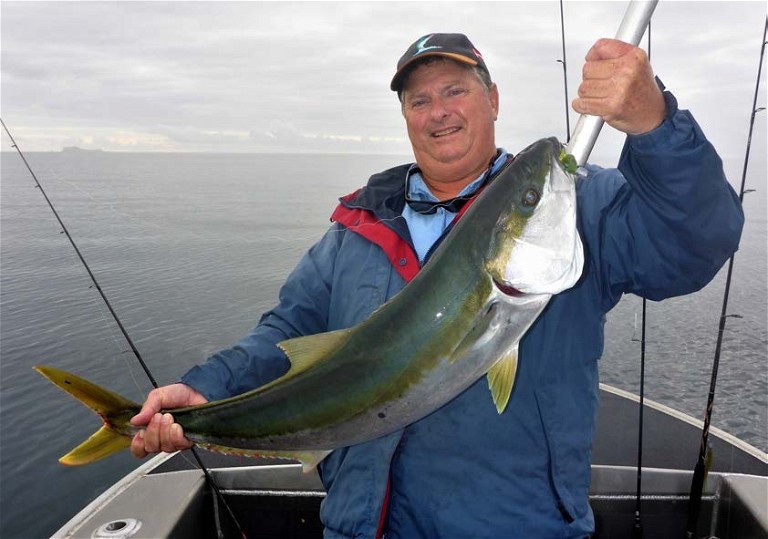
When a kingie jumps your softbait, you are in for a hard fight.
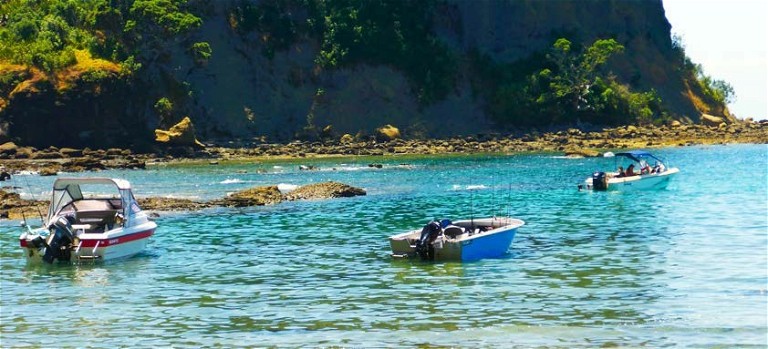
There are some beautiful spots in the Hauraki Gulf.
I also mostly fish in water less than thirty metres deep to avoid embolising fish and so aid in successful releases when necessary. When I am catching an undesirable number of small fish, I go and fish somewhere else. And, importantly, when I have caught what I need, I stop fishing.
I have gone through a number of changes of attitude to fish and fishing over the 60-odd years since I caught my first one but I now reckon that catch and release, just for the fun of it (especially in deeper water), causes unnecessary mortality and waste. To my way of thinking, catching and humanely killing fish for the table or for bait is fully justified, but risking injuring or killing them entirely for my own amusement, is not. This is a personal thing, and I am not trying to force my ideas on anyone.
As mentioned, I will still fish with cut baits when the situation demands, but I mostly lure fish, for a number of reasons: I love the concept of fooling a fish with an artificial; I love sensing the take and hooking the fish; I tend to catch a better class of fish on lures than bait; there are no issues with refrigeration, thawing bait, and messing around with berley; the boat (and your hands) stay cleaner; and the fish are mostly mouth-hooked, allowing easier releases with less mortality. Lots of plusses. Effective lure fishing is mostly done on the drift, with or without the use of a drogue to help control the drift speed, depending on the conditions. This allows the boat to cover the ground, which in turn allows presentation of the lures to fresh fish on a regular basis. You are going to the fish instead of waiting for them to come to you and I like this exploring and hunting aspect, too.
The use of a basic sounder/ GPS lets me see what is going on under me, repeat successful drift lines, and relocate hot spots. I tend to work the channels and avoid the heavy foul to avoid snagging and lure loss. Best of all, I don’t have to pull up and reset the anchor every time I want to try another spot.
A tactic that has been very successful has been a mix of casting a softbait and dragging a 40 or 60g slider lure behind the boat with the rod in a holder. As you will all know, Roddy Holder is a damn good fisherman! In the long term I would say that I catch the bulk of the fish on the cast softbait, but often – very often – the drag rod will produce the best specimen of the day.
With plenty of time on my hands, I can pick the fine weather days and avoid busy periods. It’s a good life.

Often the drag rod will produce the best fish of the day.
A TACTIC THAT HAS BEEN VERY SUCCESSFUL HAS BEEN A MIX OF CASTING A SOFTBAIT AND DRAGGING A 40 OR 60G SLIDER LURE BEHIND THE BOAT WITH THE ROD IN A HOLDER.

Snapper are not the only game in town. Mike Clay with a nice tarakihi.